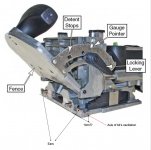Michael Kellough
Member
[member=652]JimH2[/member] wondering if “he was looking for a reason to not justify returning it” refers to me and what it means in either case. A little too double negative.
I did read about the machine at the Mafell forum and ordered the kit despite the overall ambivalence about the DDF 40 I found there. I had an immediate use for it and if the tool had lived long enough to complete the task I’d have kept it.
I did read about the machine at the Mafell forum and ordered the kit despite the overall ambivalence about the DDF 40 I found there. I had an immediate use for it and if the tool had lived long enough to complete the task I’d have kept it.

